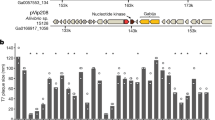Abstract
RNA as an inducer of interferon has attracted considerable interest since Isaacs, Cox and Rotem1 proposed that animal cells respond to a foreign RNA, but not to their own RNA, by producing interferon. Although this hypothesis does not appear to have been supported experimentally2, the recent findings of Lampson and coworkers3 that double stranded RNAs are potent inducers of interferon in rabbits and mice, as well as in vitro, point again to the importance of this nucleic acid. Single stranded RNAs were reported not to induce interferon, but using different kinds of cells (chick embryo cell cultures), we have shown that some single stranded RNAs, especially from Escherichia coli phage MS2, as well as some oligonucleotides obtained by digestion with RNase (ribonuclease) T1 of, for example, calf liver RNA, induce strong interference with virus growth. It is not clear, however, whether the observed interference can wholly be accounted for by the induction of interferon synthesis4,5. An especially interesting case was the “homologous” ribosomal RNA, prepared from chick embryos, which did not induce cellular resistance to virus until it had been digested with RNase T1. Some single stranded RNAs such as yeast RNA and E. coli ribosomal RNA had no appreciable inhibiting or enhancing effect on virus growth, either as such or after digestion with RNase. Also, four kinds of synthetic homopolyribonucleotides, poly A, poly U, poly C and poly I, when used singly, showed no effect on virus growth. Furthermore, double stranded RNAs obtained from rice dwarf virus6 and, by mixing poly C and poly I, were strong inducers of interference, in agreement with Lampson et al.3. It is noteworthy that, in our system, the RNAs able to induce interference also caused cell damage in certain cases, especially when used in high concentrations, whereas the ineffective RNAs showed no such effect5.
This is a preview of subscription content, access via your institution
Access options
Subscribe to this journal
Receive 51 print issues and online access
$199.00 per year
only $3.90 per issue
Buy this article
- Purchase on Springer Link
- Instant access to full article PDF
Prices may be subject to local taxes which are calculated during checkout
Similar content being viewed by others
References
Isaacs, A., Cox, R. A., and Rotem, Z., Lancet, ii, 113 (1963).
Ho, M., Fantes, K. H., Burke, D. C., and Finter, N. B., in Interferons (edit. by Finter, N. B.), 181 (North-Holland, Amsterdam, 1966).
Lampson, G. P., Tytell, A. A., Nemes, M. M., and Hilleman, M. R., Proc. US Nat. Acad. Sci., 58, 782 (1967).
Kawade, Y., and Fukada, T., Symp. Cell Chem. (Tokyo), 15, 55 (1965).
Fukada, T., Kawade, Y., Ujihara, M., Shin, C., and Shima, T., Japan. J. Microbiol., 13, 329 (1968).
Miura, K., Kimura, I., and Suzuki, N., Virology, 28, 571 (1966).
Author information
Authors and Affiliations
Rights and permissions
About this article
Cite this article
KAWADE, Y., UJIHARA, M. Non-inducing RNA antagonizes the Induction of interference with Animal Virus Infection. Nature 221, 569–570 (1969). https://doi.org/10.1038/221569a0
Received:
Issue Date:
DOI: https://doi.org/10.1038/221569a0
This article is cited by
Comments
By submitting a comment you agree to abide by our Terms and Community Guidelines. If you find something abusive or that does not comply with our terms or guidelines please flag it as inappropriate.



